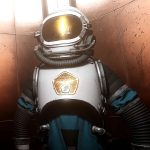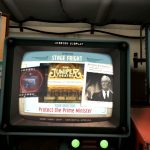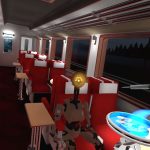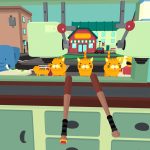Full review of the stunning Red Matter 2 from Vertical Robot on PSVR2! A sequel to the original Red Matter, this is a great showcase of the graphical capability of PSVR2.
Red Matter 2 from Vertical Robot is a mysterious sci-fi exploration adventure set in the depths of space but does it achieve lift-off or disappear into a black hole? Let’s take a look.
First up thanks to the developer for providing me with a review key for the game but as always the opinions presented here are entirely my own.
Red Matter 2 is, as you might have guessed, the sequel to Red Matter which released a few years ago on the original PSVR. The first game was actually one of my favourite titles back then as it offered up some great graphics, physics and interactivity along with an interesting story to boot, so when the sequel was announced I was curious to see if they could strike gold a second time.
This game, much like its prequel, has a very well fleshed out world and narrative.
After the events of the first game you awake in an abandoned space facility and need to piece together the story to find out what’s going on with the eponymous Red Matter, the mysterious alien substance from which the series gets its name, whilst also following up on a distress signal from an old friend who you thought was long gone.
Set in a sort of but not quite parallel dimension cold war, between the sort of but not quite Russian Volgravia and sort of but not quite American Atlantic Union, the dystopian aesthetic is beautifully realised within the architecture and paraphernalia you’ll find dotted throughout.
If you’ve not yet played the first game, or if you did but have completely forgotten the storyline, then not to worry. Within the first few areas the sequel does a good job at recapping some of what happened previously with various narrative reminders and plenty of artefacts that can be examined to provide bits of lore and backstory.
Essentially much of the game is spent exploring spacey environments, progressing the story by finding clues and solving various environmental and logic puzzles. The game eases you in by introducing the controls and concepts one by one as you play. All interactions in the game are done by a pair of claw-like multitools that you hold in your hands at all times. These can be used to grip things, scan things, hack things and, later on, light things up and shoot things, and are generally as useful as they sound. The claws allow you to grab and manoeuvre objects, open doors, interact with levers and so on. The scanner allows you to scan objects and scenery to view a description or translation, and there’s an impressive number of objects you can interact with and scan for more detail, which in turn pads out the lore of the game, but if you prefer to get on with things you can just as easily ignore many of the incidental items. Later on in the game you also get to make use of the torch and flares, which have some great lighting and shadow effects, and a projectile gun for some lite gunplay, though this is not a first person shooter by any means. Aside from attacking the occasional enemies the gun is also cleverly used to aid your progression by activating out of reach buttons and levers with a few carefully aimed shots. You also have your trusty jetpack which can get you to hard to reach places but has to be used tactically due to its short bursts and a few of the puzzles relate to working out how you can get from point A to point B by using the jetpack to hop between platforms.
I really appreciated how much interactivity there is with the world as in VR there’s nothing worse than being surrounded by scenery and objects that you can’t do anything with, or which your hands just clip through. Here you can push things, pull things, pick things up, put them inside other things, stack them up, open and close doors and hatches, wheel around trollies, swing things into other things, pull levers, turn wheels and more which, even if it isn’t always integral to the gameplay itself, all adds to the immersion. I spent more time than I care to admit hanging one coat hanger from another, stacking books and bottles and swinging a couple of glass terrariums backwards and forwards. I challenge you not to do the same when you come across them in-game!
Puzzles are often environmental in nature and involve working out how to get access to the next area but are done in such a way as to not seem forced. Occasionally you’ll encounter some more traditional logic based puzzles which are often clever but nothing taxing enough to cause frustration. I get the impression that some puzzles may have been toned down from earlier versions of the game on other platforms, particularly the hacking as it has very obvious indicators on how to solve it. I guess this was done based on player feedback and frustrations but conversely it now feels way too easy and I wish the indications weren’t so visible, or could at least be toggled on and off to add a bit more challenge.
There are some lite stealth and gunplay aspects to later sections which are brief but enjoyable. In general the variety of gameplay is good and it mixes things up between sections and introduces new mechanics often enough that you won’t get bored of doing any one particular type of challenge.
One of the first things you’ll notice with this game are the graphics. The developers have invoked some kind of wizardry to create some of the sharpest visuals seen on PSVR2 to date. It runs at a native 120fps, so no reprojection artefacts, and uses 4K textures so everything looks super detailed, even close up. It also makes use of foveated rendering to provide maximum detail within your line of sight. Combined with some incredible lighting and the great contrast of the PSVR2’s OLED display, I don’t think it’s an exaggeration to say that at times it even verges on looking photo realistic. It looks stunning and is a benchmark that I hope other developers will try to match. This is what I imagined PSVR2 games would look like, and it’s a really great demonstration of what the headset is capable of. They may have been helped to achieve this by the fact that for the most part the levels are generally fairly static, with solid walls and floors rather than having to render swathes of flowing grass as far as the eye can see, but it’s still an impressive feat.
Audio is also extremely good with lots of atmospheric environmental sounds and some stirring background music that isn’t far off a full blown John Williams score at times. The voice acting is top notch throughout and although you don’t encounter a lot of characters directly there is a lot of spoken dialogue over radio chatter, computer announcements, audio logs and so on, and everything sounds very professionally done.
As mentioned previously, controls are easy to get the hang of and as your multitools are cleverly modelled after the Sense controllers you can literally just look at them in-game to remind yourself which buttons do what. There are quite a few options for control styles and comfort settings and the game can be played seated or standing, and with the ability to crouch via the controller there’s no need to physically bend down unless you want to. There’s some good use of haptics both in the Sense controllers, for example when gripping things or shooting, and in the headset at various points like when passing through train tunnels or having visions, which is a really nice touch.
There are 25 trophies available, including a platinum, most of which are gained for progression through the game but with a few based on optional tasks that you could potentially miss during your first playthrough.
For what is essentially an indie game this punches far above its weight in all departments. It’s incredible to think that it’s made by a small team yet manages to do so much, so well. Graphics, audio, physics, interactivity and story are all so polished that I have no hesitation in recommending Red Matter 2 as an instant purchase. Arguably, being a fairly linear story driven game means there’s perhaps not a lot of replayability, aside from going back to gain trophies, but playing through the game is such a joy and a visual spectacle that it has to be experienced. The game takes around 6 to 7 hours to complete, depending on how much you explore the environment, and for the £24.99 asking price offers up not only a great game but also a real showcase for your PSVR2.





